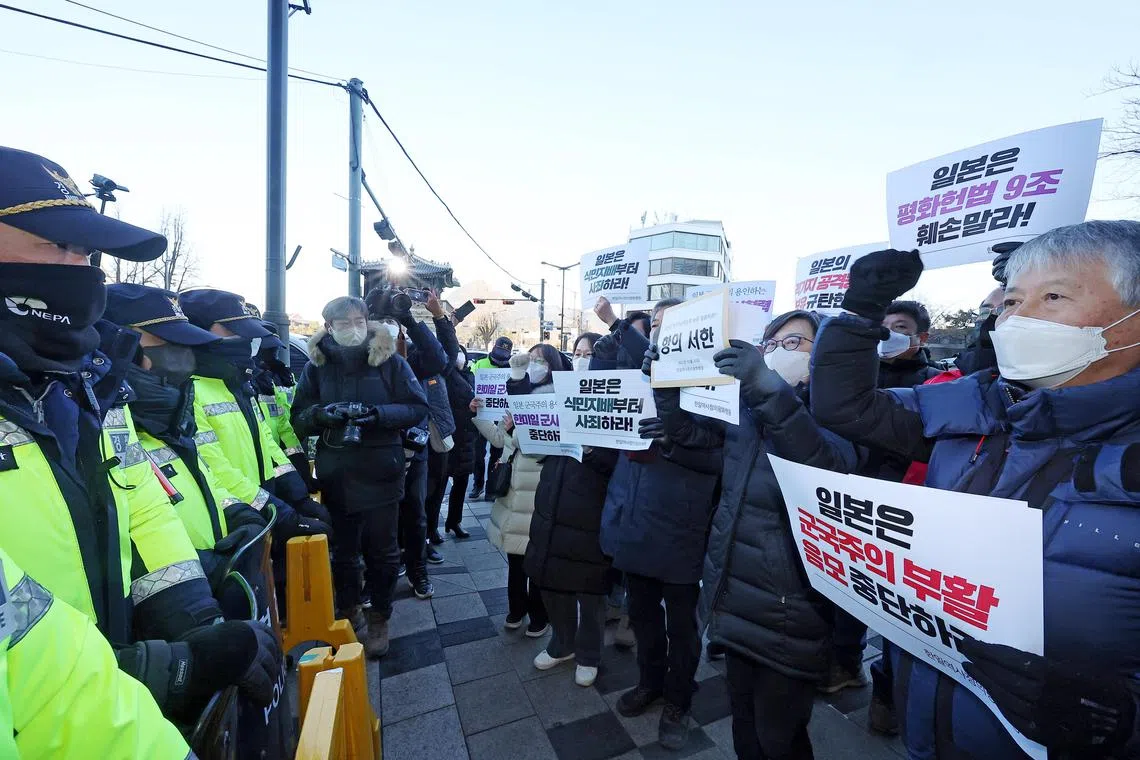Editorial Notes
Japan’s rearmament a dramatic policy change: Korea Herald
The paper says Japan’s new stance appears to have gone beyond self-defence defined under its pacifist constitution.
Sign up now: Get ST's newsletters delivered to your inbox

Protesters confront police officers in front of the Japanese Embassy, to protest Japan's decision to acquire the capability to strike enemy bases, in Seoul on Dec 20, 2022.
PHOTO: EPA-EFE
Follow topic:
SEOUL - As expected, Japan finalized the revisions to its three key security documents Friday, adopting a new security strategy that includes the possession of “counterstrike capability.” It will double its defense spending to about 2 per cent of gross domestic product.
It may be too early to say that Japan’s adoption of a new security change will be limited to purely defend itself against possible attacks from China, North Korea and Russia.
What’s certain, though, is that given Japan’s longstanding efforts to ditch its exclusively self-defence policy that had lasted since World War II, the latest changes to its security strategy herald gloomy geopolitical developments in the region.
Japan’s new stance of endorsing counterstrikes against imminent enemy attacks - pre-emptive strikes that it now justifies as constitutional - appears to have gone beyond self-defence defined under its pacifist constitution.
Not only security experts outside of Japan, but also liberal Japanese media outlets pointed out that the country’s exclusive self-defence policy has been critically undermined with the new changes to its three security documents that are usually revised every 5 or 10 years.
More worrisome is that Japanese politicians do not listen to such criticism based on facts and are expected to push for a revision to the constitution more aggressively - a gloomy prospect that will certainly accelerate military tensions in East Asia.
South Korea is one of the key military powers in the region, with its ground forces in particular showing off strong defence capabilities against North Korea’s threats. With the new security strategy, however, Japan is now bound to eclipse South Korea’s military power by doubling its defence budget to around 2 per cent of GDP, or 43 trillion yen (S$440 billion), through 2027. By then, Japan will be the world’s third-biggest military power in terms of defence budget following the US and China.
Japan’s counterstrike capability, which can be abused arbitrarily without consent from neighbouring countries, is problematic enough to leave South Korea and other nations in Asia in doubt and concerned. After all, Japan has a dark history of invading the Korean Peninsula on multiple occasions and killed an enormous number of innocent people during World War II.
With its militaristic past and the stubbornly unrepentant stance of its leaders, Japan’s newly expanded defence budget for counterstrike capability - including more long-range weapons -- raises worries about its military involvement on the Korean Peninsula.
Furthermore, Japanese Prime Minister Fumio Kishida is said to be thinking of discussing changes to its role in defence when he holds a summit with US President Joe Biden next month, seeking to reconfigure the two countries’ longstanding division of roles known as “shield and dagger.” If Japan takes more offensive responsibility, it is inevitable that the geopolitical structure in Asia will go through drastic changes.
Given that North Korea test-fired missiles frantically this year - including one that flew over Japan in October and unidentified ballistic missiles on Sunday - South Korea, Japan and the US are expected to work together to keep the North’s sabre-rattling at bay. But Japan’s military involvement or provocation targeting the Korean Peninsula based on its new security strategy is an entirely different matter.
Under the South Korean constitution, the country’s territory consists of the Korean Peninsula - including North Korea - and its adjacent islands. The potential for a territorial clash between South Korea and Japan has deepened as the latter’s revised security strategy repeats its sovereignty claim to the South’s easternmost islets of Dokdo, which is called Takeshima in Japan.
Seoul’s Foreign and Defence Ministries lodged a formal protest to Japan over its claims to the South Korean territory, but it cannot be completely ruled out that Japan, now armed with counterstrike capability, may take more provocative acts over the islets. Ominously, during a briefing held in Tokyo on Friday, a Japanese government official said its exercise of the counterstrike capability does not need approval from other nations. THE KOREA HERALD/ASIA NEWS NETWORK
The Korea Herald is a member of The Straits Times media partner Asia News Network, an alliance of 23 regional news media titles.

